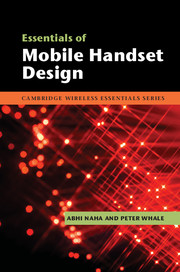3 - Design architecture
Published online by Cambridge University Press: 05 October 2012
Summary
Having examined the factors which influence the essence of handset product design and what distinguishes one handset design from another, it is now appropriate to “lift the bonnet.” We need to gain a good appreciation of what the major component parts of a handset are, how they are put together, and what the major design considerations are. This exploration will expose us to a range of high-level technical design factors, which are unpacked in further detail in the hardware and software component chapters that follow. Our goal is to continue to develop understanding of the major design decisions and challenges faced by handset designers, which result from both rapid advances in technology and the equally rapid advances in market opportunities and expectations.
Design perspective
Immediately we are faced with dilemmas over how to describe the structure and organization of a mobile handset. Depending on where we sit in the design flow, what question we are trying to answer, and which information we are seeking to understand, we will view the internal structure and organization of a mobile handset design very differently. This is because a modern mobile handset is probably the world's most complicated consumer electronics product, and contains the combined efforts of many thousands of people over tens of years. It is possible for it to be so complex, at such a relatively low price, due to the very high volumes of sales achieved, allowing the costs of R&D and manufacture to be shared out (amortized) across millions of consumers who buy the products.
- Type
- Chapter
- Information
- Essentials of Mobile Handset Design , pp. 56 - 89Publisher: Cambridge University PressPrint publication year: 2012



